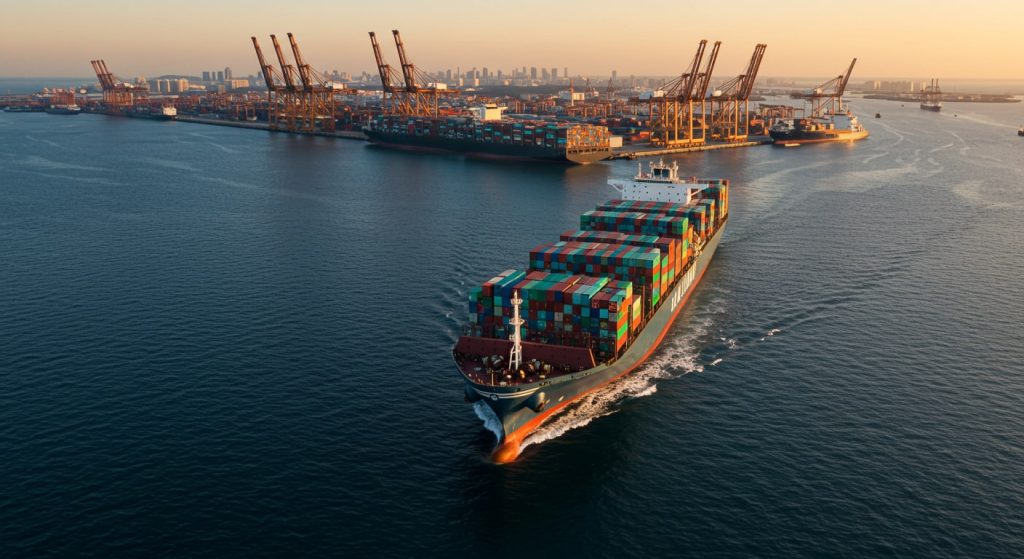
Moving goods/cargo by maritime transport, by sea or ocean is known as Sea Freight (also called, Ocean Freight). It is the most cost-efficient mode of transport to move large volumes of goods across the countries andcontinents covering the globe.
Whether it is through the narrow internal and international waterways, regional seas or through vast oceans which spans across the continents, majority of the goods are transported by this most popular mode of Sea Freight. It helps to ship anything from a small carton to oversized packages or items across the borders.
There are various types of ships that are used in Sea Freight to transport general cargo as well as specific cargo which needs specific and special features in maritime transportation.
Most common and popular types of ships used for Sea Freight are:
Container ships – These carry standard sizes of containers commonly known as 20’ long, 40’ long and 8.5’ high and 9.5’ high for use of general cargo and temperature-controlled perishable cargo. Also, some containers comes as Open Top, Open Side, Flat Rack, etc. for the use of heavy and oversized cargo.
Break bulk ships – These carry, all types of general cargo in different forms of packaging including, crates, drums, barrels, pallets, bags, bales, bundles, etc.
Tankers – These carry, crude oil, refined oil, petroleum products, etc.
Gas carriers – These carry, LNG and other types of gases.
Bulk ships – These carry, cargo in bulk form including, grains, flour, cement, clinker, coal, minerals, etc.
Liquid bulk ships – These carry, cargo in liquid bulk form including, fruit
juices, vegetable oils, palm oil, etc.
RO-RO ships (Roll On-Roll Off) – These carry, cars and all kinds of vehicles.
Reefer ships – These carry, edible fish and meat in bulk form in temperature-controlled hatches (compartments in the ship).
Nearly 80–90% of the goods in terms of volume, move by Sea Freight across the globe, making it the most important and essential mode of shipping and backbone of supply chain, world trade and world economy. The goods moving via Sea Freight includes – raw materials, food, and finished products. In 2023, the UN Trade and Development (UNCTAD) estimated that global maritime trade handled about 12.3 billion Tons of cargo, worth over USD 27 Trillion. This mammoth movement is possible due the deployment of over 120,000 ships including over 6,000 container ships.
Since the invention of the Sea Freight Container in 1956 by Malcolm McLean of USA, container shipping has become one of the most sort-after, reliable, safe, efficient and cost-effective mode of maritime shipping serving the supply chains in world trade. From a few hundreds of containers built 69 years ago, now the container shipping has grown to be an industry within the maritime shipping industry. Today, it’s huge volumes speak for itself the leading position it has gained in maritime shipping.
Following are some notable statistics and information in container shipping:
Sea Freight charges vary from container shipping to other maritime shipping. Eg; In container shipping, FCL (Full Container Load) freight is charged per 20’ or 40’ or 40’HC (High Cube) basis depending on the origin and destination of the shipment. For LCL (Less than Container Load) freight is charged per CBM/TON (Measure/Weight) whichever is higher. Whereas in most other types maritime shipping, freight is charged per Volume or Weight based on origin and destination.
Essentially in container shipping, Sea Freight services are offered by Shipping Lines as a Liner Service with regular, fixed-day, scheduled services covering many destinations across the continents. This makes it easy for Sea Freight planning and managing the complex supply chain connectivity. These large Shipping Lines are called, MLO’s (Main Line Operators).
Apart from MLOs, Sea Freight services in container shipping are also,
offered by NVOCC Lines (Non-Vessel Owning Container Carrier), mostly
catering the regional destinations.
At MendisOne, we represent several reputed Shipping Lines, including NVOCC Lines and RO-RO carriers as their Agent in Sri Lanka through our Port Agency arm – Prudential Shipping. Varied Sea Freight services are offered through these Shipping Lines.
Our Freight Forwarding & Logistics arm – Premium Trading and Logistics, provides Sea Freight services across the globe through our collaboration with Shipping Lines and global partners. We provide – reliable, cost-efficient, multiple solutions in Sea Freight, which ensures our customers shipments reach the right place at the right
time.